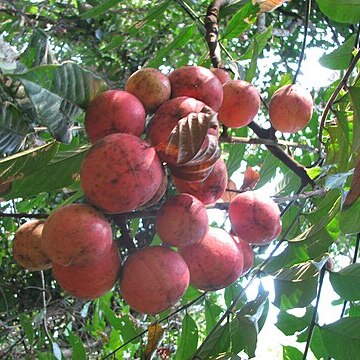Trees, dioecious or polygamo-dioecious. Leaves in spirals, large, pinnate, usually pseudogemmulate; leaflets opposite to subopposite; leaflet blades with margin entire. Inflorescences generally axillary thyrses or spikes. Flowers 4-6-merous, narrow and extended. Calyx cup-shaped or tubular, margin entire or ± dentate. Petals 4-6, distinct, linear-oblong, imbricate to valvate in bud. Staminal tube slightly shorter than petals, margin lobed or entire; anthers alternating with filament tube lobes, oblong, usually locellate. Disk usually absent, sometimes annular or shallowly cup-shaped, surrounding ovary. Ovary 2-4-locular, outside covered with thick trichomes, with 1 ovule per locule; style linear, much longer than ovary; stigma capitate. Capsule 2-4-locular, leathery, with 2-4 irregular valves. Seeds 1 or 2 per valve, thick, scutelliform to orange-segment-shaped.
Trees, dioecious or polygamous, with simple or 4-stellate hairs. Leaves pinnate and terminated by a pseudogemmula (not in some non-Australian species). Flowers sometimes with elongated receptacle (pseudopedicel), in thyrses or congested racemes on long peduncles, in axils or on branches or bole or even leaves (New Guinea). Calyx usually obscurely 3–6-lobed. Petals usually 4–6 in 1, rarely 2, whorls, usually free. Staminal tube usually cylindrical with entire or lobed margin; anthers usually 4–10, usually locellate. Disc usually absent. Ovary 2–8-locular, each locule with 1 or 2 ovules; stylehead clavate or discoid. Capsule loculicidal, usually 2–5-valved and leathery. Seeds obovoid-spheroid to scutelliform or orange-segment-shaped, orthotropous, arillate or sarcotestal.
Leaves pseudogemmulate, rarely imparipinnate or paripinnate. Inflorescences axillary, supra-axillary, cauliflorus, ramiflorous or borne on supra-axillary branches. Seeds arillate. White latex sometimes present in pith, pericarp etc. of some species.

